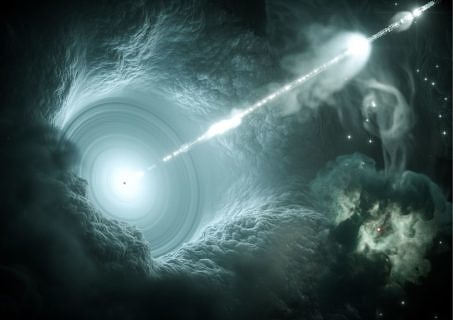Breakthrough in the search for particle accelerators in space

Researchers trace a single neutrino back to its origins billions of light years away
An international astronomical search has now been successful as a team of researchers has located a cosmic source of energy-rich neutrinos for the first time. The search began after a single high-energy neutrino was detected by the IceCube neutrino telescope in ice in the Antarctic on 22 September 2017. Telescopes on Earth and in space then determined the origin of this elementary particle. It is located in a galaxy three billion light years away in the constellation of Orion in which a gigantic black hole acts as a natural particle accelerator. Researchers from 16 observatories are involved in the campaign. Prof. Dr. Gisela Anton and Prof. Dr. Ulrich Katz from the Erlangen Centre for Astroparticle Physics at FAU are among the researchers involved in the IceCube collaboration. Their work has now been published in the journal ‘Science’.*
The observation, led by researchers in Germany, provides the first valid evidence for the origins of the most energy-rich particles – most of them protons – in space that continuously collide with the Earth’s atmosphere as so-called cosmic rays. Energy-rich cosmic neutrinos are considered a by-product from the acceleration of charged particles of cosmic rays. Thus, the observation of neutrinos implies that so-called active galaxies – such as the galaxy found to be the origin – are also the accelerators of these charged particles, i.e. quasi cosmic particle accelerators.
Experts consider this concerted observation campaign as an important success in the relatively new field of multi-messenger astronomy, which is the investigation of cosmic objects using various carriers of information or so-called messengers such as electromagnetic rays, neutrinos and gravitational waves, using various detectors and telescopes all over the world and in space.
The international IceCube team who initiated the search comprises around 300 scientists from 12 countries and is operated under the leadership of the National Science Foundation in the USA. The second-highest number of researchers in the IceCube team comes from Germany, after the USA. In addition to researchers from the Deutsches Elektronen-Synchroton DESY (German Electron Synchrotron, in Zeuthen near Berlin), nine German universities are involved in the project: Rheinisch-Westfälische Technische Hochschule Aachen, Humboldt-Universität zu Berlin, Ruhr-Universität Bochum, Technische Universität Dortmund, Friedrich Alexander-Universität Erlangen-Nürnberg, Gutenberg-Universität Mainz, Technische Universität München, Westfälische Wilhelms-Universität Münster and Bergische Universität Wuppertal.
About the IceCube telescope
For the IceCube detector, scientists drilled 86 holes into the Antarctic ice, each 2500 metres deep. Into these holes they lowered 5160 light sensors, spread out over a total volume of one cubic kilometre. The sensors register the tiny flashes of light that are produced during the rare neutrino interactions in the ice.
Five years ago, IceCube provided the first evidence of cosmic neutrinos, however scientists have not been able to locate a source for these neutrinos before now.
High priority is given to neutrino astronomy at the Erlangen Centre for Astroparticle Physics where it benefits from integration in the strong network surrounding multi-messenger astronomy, especially through close collaboration with FAU working groups on gamma telescopes such as H.E.S.S. and CTA and X-ray telescopes such as XMM-Newton and eROSITA. The IceCube working group in Erlangen led by Prof. Anton and Prof. Katz is responsible for both analysing data from the IceCube detector and developing sensors for future extensions to IceCube.
*DOI: 10.1126/science.aat1378
„Multiwavelength observations of a flaring blazar coincident with an IceCube high-energy neutrino“; IceCube, Fermi-LAT, MAGIC, AGILE, ASAS-SN, HAWC, H.E.S.S, INTEGRAL, Kapteyn, Kanata, Kiso, Liverpool, Subaru, Swift, VERITAS, VLA; Science, 2018;
DOI: 10.1126/science.aat2890)
„Neutrino emission from the direction of the blazar TXS 0506+056 prior to the IceCube-170922A alert; IceCube Collaboration“; Science, 2018
Further information:
Prof. Dr. Gisela Anton
Phone: +49 9131 8527151
gisela.anton@physik.fau.de
Prof. Dr. Uli Katz
Phone: +49 9131 8527072
uli.katz@physik.uni-erlangen.de